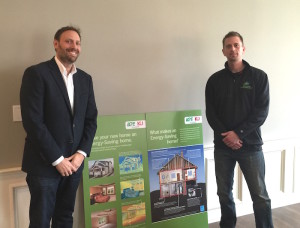
29 Feb Home Insulation With Eric George From Building Performance Group
Transcript:
Jason: Good morning, everyone. Welcome back to another episode of The Louisville Custom Home Builder Podcast. This morning I’m happy to have back Eric George with Building Performance. We had a great episode awhile back and I wanted to bring Eric back to expand a little bit. I think we’re going to hit on insulation and maybe talk about basements and whatever else comes up. With that wonderful introduction, I want to welcome back Eric George.
 Eric: Thanks, Jason, I appreciate it. Glad to be back.
Eric: Thanks, Jason, I appreciate it. Glad to be back.
Jason: Hey, man, it’s always good to have you back. I know everybody’s always interested and concerned about energy efficiency and insulation. As a builder, I’m always wanting to make sure my houses are properly insulated and always looking for the best way to do that and properly seal up a house. Let’s talk about that. I know we talked about HERS ratings and getting houses tested and getting that lower HERS rating out there, but we didn’t really get into the types of insulation used last time we talked. Why don’t you talk us through the different types of insulation and maybe the benefits of doing a blown-in product versus a traditional fiberglass batt product?
Eric: Okay. There’s three main types of insulation that’s used in new homes today. You have the traditional fiberglass rolled insulation, otherwise called fiberglass batts. You have cellulose insulation, which is a recycled newspaper and it’s chemically treated with boric acid so it’s fire retardant and mold- and mildew-resistant and things like that. That’s cellulose. Then you have spray foam. There’s different types of spray foam insulation.
The main different between them is that fiberglass and cellulose are both what’s called fibrous materials, so air easily moves through those materials. When you use those types of materials for insulation in a new home, they have to be surrounded by what’s called an air barrier. Typically the drywall is the air barrier and the sheathing on the outside of the house is another air barrier. Spray foam, though, it actually acts as an air barrier and an insulation. Because it’s so dense, because the way that the foam is cured and created, it actually stops air flow and it insulates so you don’t necessarily need an air barrier.
Jason: Okay. Does that mean it’s a better application or does it lead to a lower testing in your software that you use?
Eric: Typically, spray foam, if the house is completely spray foamed, it will be tighter than an all-fiberglass house or an all-cellulose house, nine times out of ten. What we look at from an energy-rating perspective is the installation quality of the materials. No matter if it’s spray foam or cellulose or fiberglass, we go in the house and we want to make sure that the insulation material completely fills the wall cavities. It’s getting behind and around electrical wires and pipes and stuff that are in the walls. When you’re using a product like fiberglass-rolled insulation, that insulation has to be split in half and tucked behind wires, and it’s kind of more of a manual process to do it right.
Jason: You’re relying on the actual installer to know exactly what he’s doing.
Eric: Yeah. It hardly ever gets installed the way the manufacturer said it should be installed. We grade insulation installs between one and three. A perfect install is a one and a terrible install is a three, basically. Most fiberglass batt installs are going to be a three. If you’re using a blown-in cellulose or a blown-in fiberglass in your walls, it’s going to completely fill that wall cavity. It’s going to get all behind the wires and the pipes. That’s going to effectively be a grade one as long as it’s completely filled. That’s kind of the main difference between the insulation types.
Jason: I know we haven’t used fiberglass insulation in awhile and the batts… Do people still use that insulation method?
Eric: Yeah, it’s still the favorite, the most common method for insulating homes because the Pink Panther from Owens Corning’s got it drilled in our head that he’s the way to go and so most builders use fiberglass insulation, whether it’s good or not. It’s fast and it’s cheap.
Jason: That’s what, I guess, it boils down to. It’s probably the cheapest way to insulate, whereas I guess on a scale, fiberglass would be the cheapest, the blown-in cellulose would kind of middle-of-the road, then the foam is going to be your most expensive option, is that right?
Eric: Yeah, and then of course you have other high-end products like SIPs panels and ICF walls and things like that, but those are very niche products and you don’t see them used real often.
Jason: All right. Got you. I know you mentioned that the fiberglass and the cellulose has to have an air barrier. What about when you get into the basement and insulate those basement walls or do you have to insulate a basement wall? Talk to me about that.
Eric: Yeah, the energy code in Kentucky and Indiana changed a couple years ago in 2012. It was actually required before that you insulate the basement walls, but it wasn’t enforced, and now they’re starting to enforce it finally. Yes, you have to insulate your concrete basement walls to two foot below the outside grade. Typically what that means is you need to insulate at least the top four feet of your walls.
There’s a really good reason why. Most people don’t know that eight inches of concrete has about the same resistance to heat transfer as a single-pane glass window, believe it or not. Concrete absorbs heat really well and it releases heat really well. It also absorbs moisture vapor really well and releases that into the house. You need to insulate at least the top four feet of your basement walls now. It is code requirement.
Jason: Will our homeowners notice a considerable difference in the comfort level of their basement by the new energy codes and having that basement insulated?
Eric: They really should, yes, especially if it is a finished basement. They should definitely notice a difference because, let’s put it this way… There’s two kinds of ways that you can insulate your basement. You either frame it up and you put the insulation in between the studs, or you put a foam board or a spray foam directly on the concrete. My opinion and our experience has showed that it actually is a lot more effective to put the board or the spray foam right against the concrete so that you don’t have kind of a gap between the wall and the insulation where air can circulate. Absolutely.
I bought a house a few years back that did not have a finished basement. It was not insulated. We put two-inch foam board from the top to the bottom all the way around and even before I put up the drywall or anything else, I could notice an immediate difference. Just felt more comfortable.
Jason: You know, I think a lot of people just don’t realize, and as a builder who’s built several hundred custom homes, I guess up until recently, I didn’t realize how poor of an insulator an eight-inch concrete wall was. It’s very eye-opening to hear that it’s an R1 or 2 or whatever a concrete wall is. I’m glad you’re helping us build more efficient homes. To me, that makes a happier customer who’s going to enjoy that basement a little bit more. That’s good to know and hopefully we’ll get some better-insulated homes out there. Is there anything to be concerned about in the basements with moisture or anything like that when you’re putting insulation on the wall?
Eric: Yeah, absolutely. Again, it kind of goes back to I guess the last podcast when we were talking about the drainage issues around houses. For example, in Norton Commons, the houses are fairly close together and if you don’t take into account the drainage that happens in between the houses, you can get a lot of saturated ground around the basement. That groundwater’s got to go somewhere and it’s going to go to the driest area it can. If the basement is a lot more dry than the ground outside, then that water vapor eventually will make its way inside.
To your question about issues with moisture or whatever inside the basement, say you did have a drainage issue and you insulated the basement walls with fiberglass insulation or there’s another product called blanket wrap. It’s basically a fiberglass roll that’s four feet wide and it has a big, vinyl face on it. I call them basement diapers. It basically looks like a big diaper on the inside of your basement if it’s not finished. What I don’t like about those is that vinyl facing basically will trap moisture between the concrete wall and the vinyl. If you do have any moisture issues, it will kind of wick moisture from the concrete wall. It is important to use the right products in the basement and it will definitely affect the indoor air quality and things like that as well.
Jason: While we’re talking about basement and comfort, we haven’t touched on this yet and I just want to get your opinion on, you know a lot of people always complain that the basement’s always a little bit cooler or a little bit warmer than, say, the first floor. Some of that may be that it was never properly insulated, but I guess another option is, do you recommend or what do you think about a zoned heating and cooling system? Say your first floor’s on the same system as your basement and you put in a damper system and put a thermostat in the basement. Is that an effective way to control the temperature? What are your thoughts on zone systems?
Eric: My opinion of zoned systems is that it’s a Band-Aid on a problem. You’re saying that, “One part of my house is a different temperature than another part of my house and so I’m trying to adjust or change the HVAC system to accommodate for that.” It kind of goes back to, again, is the house insulated properly and air-sealed properly because if it is, you shouldn’t have big temperature differences in different parts of the house. My opinion is if you properly size the heating/cooling system, and the duct work as well, the duct work is a huge part of it, if you properly size the duct work and the heating/cooling system and it gets the air flow to the rooms that it’s supposed to, then you shouldn’t have a need for a zoned system.
Jason: Okay. Interesting. Do the homework up front, get it sized right, and it should operate efficiently.
Eric: The other thing to consider, real quick, on zoned systems is you really typically need to have a higher-efficiency equipment attached to it, so it needs to be like a multi-staged or a variable-speed system because if you just throw a zone damper system on a basic furnace, it’s going to choke the air flow through it and it’s going to make it actually less efficient then it would be otherwise.
Jason: Yeah, I’ve heard some horror stories of I guess once one zone may call for it and the furnace kicks on at full-speed, it sounds like maybe an aircraft is taking off, all that air is coming through one zone. Okay, that’s great feedback. A variable or some type of high-efficient furnace when you go into a zone system.
I know we touched on a little bit, but I know I hire your services to inspect my homes, but what is that process like with a typical home? When you’re inspecting, that second phase that we talked about, the pre-drywall inspection, do you find that most insulation contractors are doing a good job or do you go in and say, “Hey, pass, you’re good to drywall,” or do you usually find items that even the most experienced professionals miss when they insulate these houses?
Eric: We always find something. Not every single house we’re going to find something, but more often than not, especially with custom homes, they’re larger, they’re a little bit more complicated and so they take more attention to detail. What we find a lot is not necessarily the insulators fault, it’s the way that the house was framed and it may make it more difficult for the insulator to do his job. If we’re working with the builder from the beginning and it’s a brand-new model or whatever, we might actually want to look at it before you get done framing the house just to make sure that maybe the framer can do a couple things differently to make it easier for the insulation guy to do his job.
We always find something. We find disconnected duct work in houses that are about to get drywalled. We find sections of ceilings and walls and rim joists that have been missed insulation or improperly insulated. There’s all kinds of weird stuff that we find in new homes. Builders are busy. They have a lot of things going and they’re not necessarily paying attention to the detail that we are.
Jason: That’s the reason I hire you on my homes is because I pay a lot of attention to the details and I am involved and I am through the house, but there’s so much to insulating and the last thing I want is to have a homeowner move into a house and have maybe a finished room over the garage that wasn’t insulated properly yet. It could have been all foam, but they missed a certain spot that air’s coming right into that passageway and causing some discomfort.
I’m always amazed at what you find in my houses that I was like, “Eric’s not going to find anything on this one.” Sure enough, he always finds several things, which is why we keep you bringing you back in for more. I know we jumped right into it, Eric, what is your background? How do you become an expert in building performance? Give us a little intro on how you got to where you are.
Eric: My background’s a little unique for most people who are doing energy ratings these days. I actually started out in the insulation industry. My parents owned a small insulation company north of Indianapolis. They bought it when I was in high school and I worked off and on through college with that company. After college, a friend of mine from school decided to take it over and we took a new kind of direction with the company. We started focusing on the custom home market and also the other end of the spectrum was low-end weatherization assistance programs.
In Indiana, if you qualify, you can have community action programs basically pay to have your home weatherized. We went through a ton of training through an organization called INCA in Indianapolis that trains you all about how to do air leakage testing and air sealing and duct leakage testing and duct sealing. Not only how to test it and find it, but actually how to fix it and do the insulation part of it. That was kind of the base of our knowledge in building science. We insulated hundreds and hundreds of houses through that program and also custom homes.
The other half of my experience came from another company that my parents owned called Paul Davis Restoration, fire and water damage insurance restoration company. With that company, you’ve got flood-damaged houses that you’ve got to dry out and repair.
It was going through training from both angles of it. I got to see not only how to create new homes or make existing homes more tight and well-insulated and more comfortable, but from the restoration side, you got to see how homes are damaged by water and air leakage and other defects in buildings. The science is very closely related. Heat transfer and drying buildings is all very closely related. It gave me a really unique background and perspective on kind of the building science industry. It made me it easier for me to kind of jump from being an insulator to being an energy auditor and a rater for new construction.
Jason: It’s a great background. There’s a lot of people that do what you do, but you definitely are, I think, the expert in the industry and it’s a testament to your background to actually have insulated houses and to know the pieces. That’s fascinating.
Eric: It makes it a lot easier for us to talk to the insulation guys and the heating/cooling guys, too, because we’ve been there and done it. We can tell them some tricks and techniques to do what they do better.
Jason: Fantastic, man. Again, it’s a pleasure having you aboard again. Why don’t you give folks a good way to contact you if they have any additional questions?
Eric: Okay, yeah, our phone number is 502-509-5535. The website is buildingperformancegroup.com. You can also find us on YouTube and Facebook.
Jason: Great. Well, thanks again, Eric, and we’ll talk to you soon.



